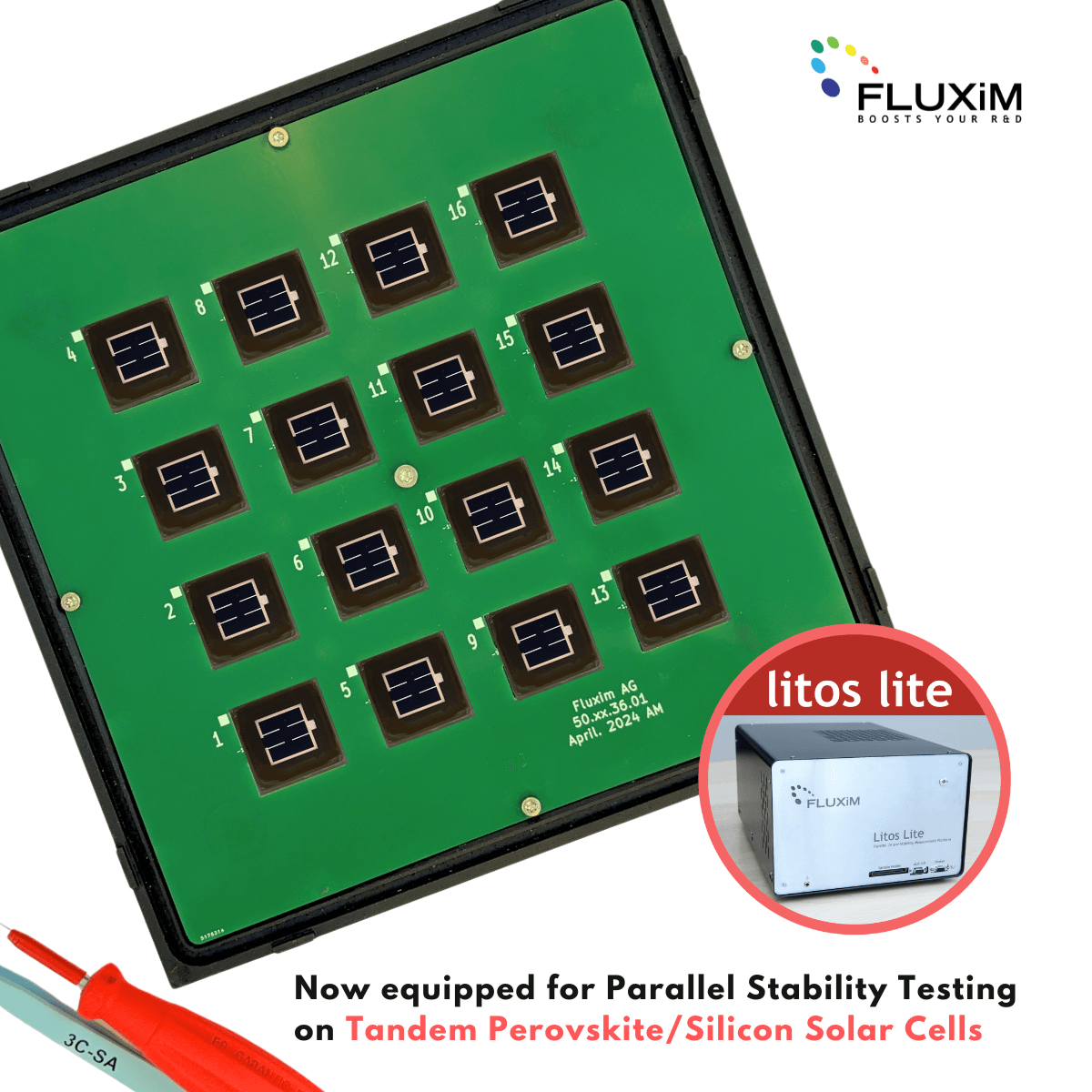A New Sample Holder for Tandem Perovskite/Silicon Solar Cells
Great news for tandem solar cell researchers: Litos Lite now features a custom-made sample holder designed for tandem Perovskite/Silicon solar cells. This new holder enables high-throughput stability testing and JV characterizations in parallel for your tandem PVs.
Key Features:
Stress and characterise up to 16 tandem solar cells simultaneously
Custom sample holder designed according to your sample layouts
Test each device at an individual constant voltage or MPP
Seamless integration with our user-friendly software
This new sample holder is now available for immediate order to all existing Litos Lite customers. If you’re considering a complete Litos Lite package, we would love to discuss your research needs and explore how Litos Lite can be tailored to support your work.
Why Choose Litos Lite?
Up to 56 parallel channels for JV characterizations and stability measurements
Customizable sample holders designed on your device layouts
Compatible with your existing or new solar simulator
Full technical support to assist with your research needs
Compatible with several ISOS protocols
Lead the way in solving perovskite solar cell stability issues by adding this powerful instrument to your lab.
For more information, please contact us at sales@fluxim.com.
EU PVSEC 2024 Vienna
Are you attending EUPVSEC next week in Vienna? If you are attending, you can see the new sample holder in person at the Fluxim booth (C12) where Dr. Urs Aeberhard will be available for expert advice.
Urs will also be giving the following oral presentation:
Multi-Scale Simulation of Non-Idealities in All-Perovskite Tandem Photovoltaic Modules
Wednesday, September 25th, session 2CO.1 13:30 - 15:00
Latest Research
Optical multiscale model for quantification of photon recycling including incoherent light scattering
Simon J. Zeder, Balthasar Blülle, Beat Ruhstaller, and Urs Aeberhard, Opt. Express 32, 34154-34171 (2024)
https://doi.org/10.1364/OE.522953
This paper presents a multiscale optical model developed to accurately quantify photon recycling (PR) and luminescent coupling (LC) in optoelectronic devices such as solar cells and LEDs. Photon recycling, the process of photon emission, re-absorption, and re-emission, can significantly enhance device efficiency, particularly in materials like GaAs, metal halide perovskites and even crystalline silicon. To accurately account for re-absorption effects, the model treats light absorption and emission equally, considering the full spectrum of internal modes within the device. This approach stands out from conventional methods, which focus solely on exterior-coupled modes.
The framework integrates two key propagation models:
Coherent Wave-Optical Model: Applied to thin-film layers where light interference effects are significant, avoiding unphysical divergencies for emitters embedded in absorbing media and ensuring consistency with detailed balance principles.
Incoherent Ray-Optical Model: Used for optically thick layers where coherence is lost, treating phase relations as irrelevant.
The model also accounts for light scattering at textured surfaces, essential for devices like perovskite –silicon tandem solar cells. By merging these approaches, the paper provides a robust framework for computing local emission, re-absorption, and energy flux rates in devices with complex structures. Importantly, this allows for a detailed understanding of the impact of photon recycling on device performance, including enhanced external quantum efficiency (EQE) in LEDs and increased open-circuit voltages in solar cells.
The model is validated through comparisons with analytical solutions, showing excellent agreement, and applied to a textured perovskite solar cell showcasing its capabilities. This validation confirms that the model can reliably be applied to real-world devices, offering a powerful tool for optimizing the performance of next-generation optoelectronic systems.
Key Takeaways:
Comprehensive multiscale approach merging coherent and incoherent light models.
Applicability to complex textured devices like perovskite solar cells and LEDs.
Quantification of local re-absorption and energy flux rates.
Validation through comparison with analytical solutions.
Congratulations Dr. Zeder!
Our colleague Simon Zeder (first author of the paper above) has achieved a significant academic milestone with a successful defense of his PhD at EPFL (École Polytechnique Fédérale de Lausanne), titled “Advanced Modeling and Simulation of Luminescence Phenomena in Perovskite Semiconductors”, which he completed through Fluxim under the expert supervision of Fluxim’s Dr. Urs Aeberhard and Prof. Christophe Ballif (EPFL). Simon already has an impressive academic record with multiple publications, focusing primarily on optoelectronic devices such as solar cells and LEDs.
His key works include:
Photon Recycling in Perovskites: A series of papers, including "Reconciliation of dipole emission with detailed balance rates" and "Assessment of photon recycling in perovskite solar cells," exploring the optimization of light absorption and emission in solar cells and PeLEDs.
Advanced OLED Modeling: He contributed to OLED research through works like "Coupled 3D master equation and 1D drift-diffusion approach."
Optoelectronic Simulations: His work emphasizes full optoelectronic device simulations, vital for improving efficiency in both solar cells and LEDs.
Simon has been and continues to be an integral part of Fluxim, working on developing numerical algorithms and physical models, and implementing them into our simulation tools. His ability to bridge the gap between theoretical research and practical applications has already begun to enhance our work, particularly in photovoltaic device modeling.
Congratulations, Dr. Zeder! Your achievements are a source of inspiration, and and we look forward to seeing how your research will drive progress at Fluxim and in the broader field of optoelectronics. Simon will be continuing his career at Fluxim as a Computational Scientist.




